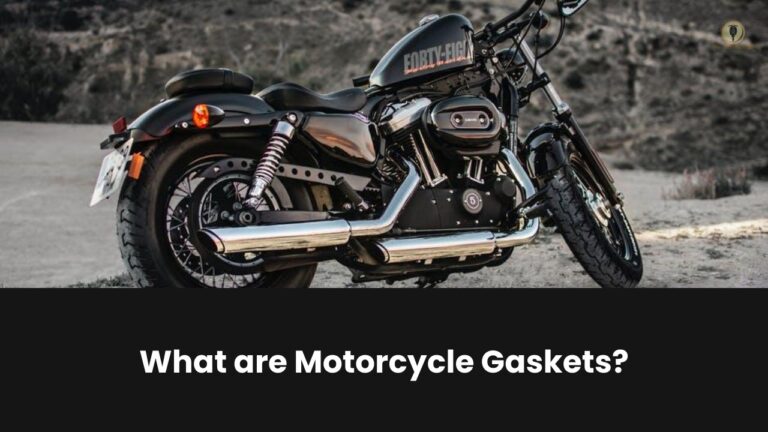A gasket is a mechanical seal that fills the space between two or more mating surfaces. It can help prevent leakage on equipment and fixtures, often during compression.
Almost every vehicle needs gaskets to prevent leakage in the engine and other components.
Gaskets fill in the spaces where components of a machine or fixture have gaps. They’re used throughout all sorts of applications and industries, including construction, cars, planes, coffee makers- anything! These gaskets come in many shapes and sizes depending on what they need to do, from stopping leaks for your car’s engine oil pan as well as preventing water leakage with an ice maker.
Can you Re-use the Motorcycle Engine Gaskets?
The Gaskets are also widely used for motorcycles. But you should know that motorcycle gaskets and seals are designed to use one time for your motorcycle, which means you have to replace the gaskets once these are old or if you want to do some maintenance of your motorcycle. If you use the same gasket, chances are you may ruin the motorcycle parts instead of helping.
This article is about motorcycle engine gaskets, so we will discuss what kinds of gaskets are available for your motorcycle and how to use these:
Types of Motorcycle Gaskets:
Motorcycle gaskets save your bike from wear and tear. There are many kinds of motorcycle gaskets. Here are two types of those:
1. Motorcycle Exhaust Gasket
2. Motorcycle Head Gasket
1. Motorcycle Exhaust Gasket:
Why should you use an Exhaust Gasket for your ride? Exhaust leaks are like a wet blanket on your tailpipe. Imagine trying to ride a motorbike with an exhaust leak, and you’ll get the idea about how much it can impact performance.
Like motorcycle’s other parts, a gasket is also used for motorcycle exhaust. However, as these gasket ages, it is essential to replace these.
Why Exhaust Leaks Impact the Performance?
The exhaust is a necessary part of the engine, and when it leaks, there’s no escaping its effects. The leaking fumes from your motorcycle can impair not only visibility but also reduce performance.
The Solution:
Always consider using the Exhaust Gasket for your motorcycle, which not only fits but also prevents any leaks.
As a suggestion, you can use the exhaust gaskets from Vanes & Hines or Louis.
2. Motorcycle Head Gasket:
If you ignore your motorcycle’s head gasket, chances are you may be riding your motorcycle with a blown head gasket without being aware of it. However, something you should know is, this can leave a motorcycle rider in danger and can cause harm to the motorcycle’s engine.
How to Determine if the Head Gasket is Blown?
One of the key indicators that you may have a head gasket issue is seen through your engine temperature. If it’s suddenly increasing, chances are you’re already experiencing problems with your head gasket.
The Solution:
Once you come to know if there is a problem with your motorcycle’s head gasket, it is time to replace it or get it replaced by an expert.
Is it easy to add a Gasket to your motorcycle?
It can easily be done by using the gasket sealer. If you know how to do that, you can add the sealer yourself. Otherwise, you can pay an expert to do it for you.
However, here is a video about how to use a sealer for adding a motorcycle gasket.
Some Frequently Asked Questions about Motorcycle Gaskets:
After reading this article, you may have learned about motorcycle gasket, their types, and how to use them. But you might still have some questions. Here are some questions, with answers to help you understand it even more:
What are motorcycle head gasket leak symptoms?
Motorcycle head gasket leak symptoms:
- The oil is leaking from the engine, and there is a lot of smoke coming out.
- There is an odor that smells like gasoline inside or outside your motorcycle.
What Causes Motorcycles Overheat When Riding?
Overheating can be caused by many reasons such as dirty air filter (clogged), not enough coolant level, etc., and riding at too low speed for a long time (riding without gear in the mountains, or when it’s very hot).
What material is better for the motorcycle gasket?
Different materials may offer different advantages and disadvantages. For example, a rubber gasket is elastic; this means it can be stretched to fill a wide range of gaps between mating surfaces.
The downside is that it doesn’t last long because the high-pressure engine oil will break down the material over time. Silicon gaskets are also easy to install correctly without leaks, but they don’t have as much flexibility or durability as rubber ones.
How long can the gasket sealer last?
Gasket sealer is a type of adhesive used in car motors, and it comes in the form of a putty-like substance. It’s always important to use this product before attempting any repairs or replacements so that dirt can’t enter through the opening.
Otherwise, your bike will end up with clogged or damaged parts. However, it should be noted that gasket sealer usually only lasts for a maximum period of 6 months following application. If you’re still experiencing leaks around certain areas after 6 months, you should invest in some other method to seal off those gaps.
Conclusion:
So what did you learn from this article? You learned that if your motorcycle is not maintained, it can have some severe consequences. The best way to keep your bike running smoothly and avoid costly repairs down the road is by doing a little maintenance regularly.
Keeping your motorcycle in great condition isn’t only limited to Gaskets. There are many more things to consider you’ve been neglecting these basic steps for a while now, we encourage you to get back into the habit of routine upkeep. From replacing fluids like oil and gas, taking care of brake pads, or even making sure there are no loose bolts. When done regularly will provide peace of mind knowing that everything under the hood is in good working order and ready for any adventure without breaking down along the way!

